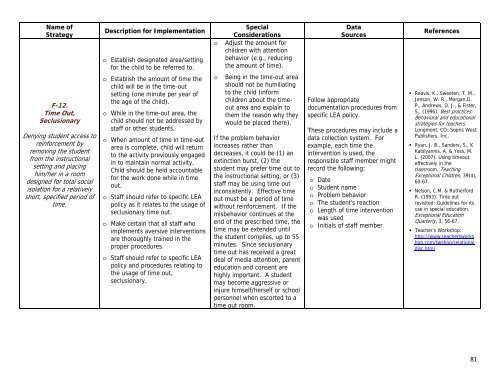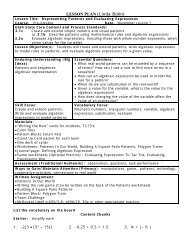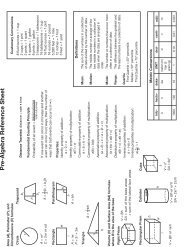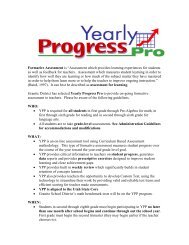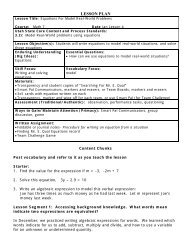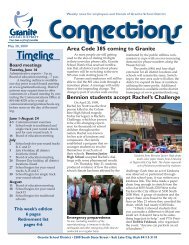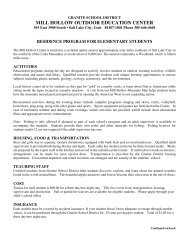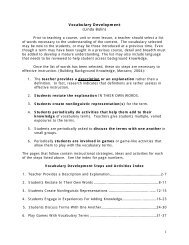Utah's Least Restrictive Behavioral Interventions Guidelines
Utah's Least Restrictive Behavioral Interventions Guidelines
Utah's Least Restrictive Behavioral Interventions Guidelines
You also want an ePaper? Increase the reach of your titles
YUMPU automatically turns print PDFs into web optimized ePapers that Google loves.
Name of<br />
Strategy<br />
F-12.<br />
Time Out,<br />
Seclusionary<br />
Denying student access to<br />
reinforcement by<br />
removing the student<br />
from the instructional<br />
setting and placing<br />
him/her in a room<br />
designed for total social<br />
isolation for a relatively<br />
short, specified period of<br />
time.<br />
Description for Implementation<br />
o Establish designated area/setting<br />
for the child to be referred to.<br />
o Establish the amount of time the<br />
child will be in the time-out<br />
setting (one minute per year of<br />
the age of the child).<br />
o While in the time-out area, the<br />
child should not be addressed by<br />
staff or other students.<br />
o When amount of time in time-out<br />
area is complete, child will return<br />
to the activity previously engaged<br />
in to maintain normal activity.<br />
Child should be held accountable<br />
for the work done while in time<br />
out.<br />
o Staff should refer to specific LEA<br />
policy as it relates to the usage of<br />
seclusionary time out.<br />
o Make certain that all staff who<br />
implements aversive interventions<br />
are thoroughly trained in the<br />
proper procedures.<br />
o Staff should refer to specific LEA<br />
policy and procedures relating to<br />
the usage of time out,<br />
seclusionary.<br />
o<br />
o<br />
Special<br />
Considerations<br />
Adjust the amount for<br />
children with attention<br />
behavior (e.g., reducing<br />
the amount of time).<br />
Being in the time-out area<br />
should not be humiliating<br />
to the child (inform<br />
children about the timeout<br />
area and explain to<br />
them the reason why they<br />
would be placed there).<br />
If the problem behavior<br />
increases rather than<br />
decreases, it could be (1) an<br />
extinction burst, (2) the<br />
student may prefer time out to<br />
the instructional setting, or (3)<br />
staff may be using time out<br />
inconsistently. Effective time<br />
out must be a period of time<br />
without reinforcement. If the<br />
misbehavior continues at the<br />
end of the prescribed time, the<br />
time may be extended until<br />
the student complies, up to 55<br />
minutes. Since seclusionary<br />
time out has received a great<br />
deal of media attention, parent<br />
education and consent are<br />
highly important. A student<br />
may become aggressive or<br />
injure himself/herself or school<br />
personnel when escorted to a<br />
time out room.<br />
Data<br />
Sources<br />
Follow appropriate<br />
documentation procedures from<br />
specific LEA policy.<br />
These procedures may include a<br />
data collection system. For<br />
example, each time the<br />
intervention is used, the<br />
responsible staff member might<br />
record the following:<br />
o Date<br />
o Student name<br />
o Problem behavior<br />
o The student’s reaction<br />
o Length of time intervention<br />
was used<br />
o Initials of staff member<br />
References<br />
• Reavis, K., Sweeten, T. M.,<br />
Jenson, W. R., Morgan,D.<br />
P., Andrews, D. J., & Fister,<br />
S., (1996). Best practices:<br />
<strong>Behavioral</strong> and educational<br />
strategies for teachers.<br />
Longmont, CO: Sopris West<br />
Publishers, Inc.<br />
• Ryan, J. B., Sanders, S., K<br />
Katslyannis, A. & Yess, M.<br />
L. (2007). Using timeout<br />
effectively in the<br />
classroom. Teaching<br />
Exceptional Children, 39(4),<br />
60-67.<br />
• Nelson, C.M. & Rutherford<br />
R. (1993). Time out<br />
revisited: <strong>Guidelines</strong> for its<br />
use in special education.<br />
Exceptional Education<br />
Quarterly, 3, 56-67.<br />
• Teacher’s Workshop:<br />
http://www.teachersworks<br />
hop.com/twshop/relational<br />
disc.html<br />
81


